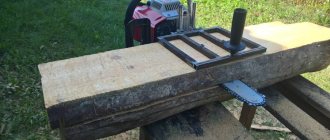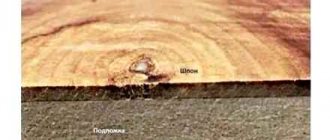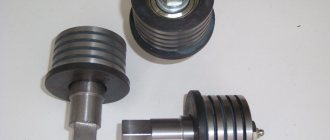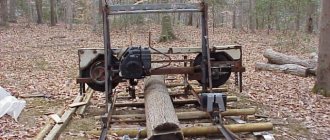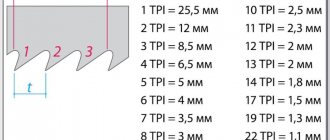Manual work: using a chainsaw
For home cutting of several trunks, it is not advisable to purchase a tool whose cost is several times higher than the price of finished products.
If you have the necessary skill, then it is more efficient and cheaper to do all the necessary work with a conventional chainsaw or chain equipment powered by electricity. Of course, such work requires much more physical effort and time, but the cost of the issue is significantly reduced. Working on a garden plot requires pruning fruit trees, and it also becomes possible to additionally produce material for outbuildings without resorting to the services of specialists, so any thrifty owner will prefer to buy a chainsaw. Most often, coniferous wood is harvested for the home, and this tool does an excellent job of cutting it. Thanks to straight trunks, it is easier to mark cutting lines, which increases the speed of work. Professionals, by the way, most often use a chainsaw, since it is more powerful than an electric one and can be used anywhere, regardless of whether there are power sources at the cutting or cutting site.
Wood cutting options
To use a chainsaw to cut logs, you will need a device such as a saw attachment, as well as cutting guides and base-trunk fasteners. The frame-shaped attachment is attached to the tool so that it remains possible to adjust the distance between the chain and the frame itself. This is done to make it possible to produce finished lumber of different thicknesses. For the role of a guide, you can take either a profile of the required length, or a flat wooden plank with sufficient rigidity. A special chain is selected for the tool, designed to cut the trunk lengthwise. Its difference from the others lies in the teeth sharpened at a certain angle.
Before you start work, you need to not only prepare all the necessary tools. Regardless of whether a woodworking machine or a manual device is intended for processing the trunk, the first thing you need to do is familiarize yourself with the cutting map. This is done in order to minimize the percentage of waste and increase the yield of useful products.
The first thing you need to worry about when cutting longitudinally is the uniform density of the finished boards. To do this, a competent sawyer directs the tool from the east side of the log to the west, or in the opposite direction. This is explained by the higher density of round timber in its northern part than in the southern part.
Next, use a chainsaw to remove the slab from both sides so as to obtain a double-edged beam. It, in turn, is sawed in accordance with the cutting pattern chosen at the beginning of the work. The solution is an unedged board. If there is a certain percentage of defects in the trunk, then a circular cut is possible with the trunk turning at a right angle or 180°.
Practical advice for the operator
In order to earn maximum profit, you need to teach your operator to distinguish the product by grade and value. After all, it is not advisable to cut good material into railroad sleepers, since the boards are more valuable.
Experts suggest using circular sawing for high-quality lumber. Carry out cutting taking into account the taper of the log. Recommended for cutting “useful” edges. The result of such operations will allow you to obtain clean wood material along the entire length. Having reached a bad section of the log, it is necessary to switch to a form in the form of a beam. This will minimize the cost of trimming the sides.
Follow the manufacturer's recommendations. Monitor the machine settings, the condition of the bed, and periodically inspect belts and pulleys. This will allow you to achieve maximum and high-quality cutting on the saw.
“How to set sizes?” - You ask. There is nothing complicated. It is enough to equip the machine with a ruler. It will help the operator with calculations. There will be no need to bother your head with mathematical calculations. Add a closer and the process will become almost automated. The program itself will convert the tape to the desired size. This will reduce the time for cutting material and increase productivity.
Preparing for work
Before starting work, it is recommended to sort the trees depending on their purpose. It is necessary to clean them from dirt, remove knots and nails. Sorting is done according to the following criteria:
- trunk diameter;
- curvature;
- number of knots, various defects;
- core diameter.
Immediately before cutting you need to:
- Check the quality of fastenings and connections of parts.
- Check for grounding.
- Lubricate surfaces subject to friction.
- Check that the band saw is installed correctly.
- Check the belt movement at idle and reverse.
- If necessary, change the saw boom by moving the roller on the left side by 5-10 cm.
The log, prepared in this way for sawing, is placed on the frame and securely secured with clamps. You need to make sure that it moves freely between the guides.
Firstly.
We pay attention to all the bends and bulges of the log - a perfectly straight trunk is rare. Therefore, we try to turn it so as to get as little waste as possible from it, such as croaker. When the log is laid and fixed, you should make sure that it passes freely between the guide rollers.
Set the diameter size on the ruler of the sawmill, and to this size add the greatest height of the convexity of the log. This is the bulge that is higher than the diameter of the top or narrowest part of the log.
Using a regular tape measure, measure the height of the highest part, and from this size you begin counting the dimensions of the required material, taking into account the size of the cut, which ranges from 2 to 5 mm.
Cutting wood
Before choosing a tool, you need to decide on the type of cut, focusing on the annual rings of the log. There are several types:
- radial (along the radius);
- tangential (the cut is parallel to one radius and touches the annual rings);
- the fibers are located parallel to the cutting being performed.
Among the cutting methods, the one that is most suitable for a particular case is selected:
- Waddle. Sawing wood in this way is carried out for deciduous trees with a small trunk thickness, and is considered the simplest processing. Output: unedged elements and slabs.
- If you have another forest processing machine, then it is possible to cut up to 65% of the material to produce edged boards of equal width. First, the double-edged timber and boards on the sides are cut, and then a certain amount of edged lumber is obtained from the timber.
- More specific methods are sector and segment sawing. The number of elements in the first method varies from 4 to 8, and depends on the thickness of the trunk. After dividing, elements are cut from each sector along a tangential or radial line. The second method begins with the timber coming out of the central part, and boards are cut from the side segments in a tangential direction.
- For individual cutting of wood, the circular method is suitable. It is based on turning the log along the longitudinal line by 90° after each sawn board. This allows you to monitor the quality of the wood and promptly remove affected areas of the trunk.
Execution order
Sawing logs begins with the fact that you free the logs from bark and branches that might remain. Then you inspect the lumber for various defects and decide on a suitable cutting pattern. The possible amount of waste will depend on this.
Of course, sawing on a band sawmill is much easier, but with a gasoline saw everything will work out if you adapt well. When radial cutting of wood is performed, they try to obtain boards that have the same density across the width. A common pattern for sawing logs is from east to west. On the north side the density is greater. Cutting in the opposite direction is allowed.
The first operation is to remove the slab (top part), as if on a board. You will receive timber cut into boards of equal thickness. The result of sawing will be an unedged board. Subsequently, the edge is removed from it.
Sometimes sawing round timber ends with a false core or other defects being discovered in the log. The problem is solved by rotating the workpiece 90 or 180 degrees, as with a circular cut.
Features of wood processing
Cutting chart for automated wood processing
The instructions for processing raw materials and obtaining lumber products consist of a number of technological operations, including longitudinal cutting of logs, trimming lumber and cutting to width, sorting by standard sizes, sorting by quality of workmanship, drying and storage.
Each of the listed stages is important from the point of view of the quality of the finished product. But cutting is the most labor-intensive and critical stage, during which the main characteristics of the finished lumber are formed.
Slicing diagram for common lumber products
Drawing up a plan for cutting logs into lumber (choosing a suitable processing method) depends on the type of wood, the size of the raw material, the degree of humidity, the density and hardness and many other factors. Of course, the method of processing raw materials is determined to a large extent based on the level of technical equipment of the enterprise.
Let's consider what equipment is used for industrial sawing of wood and what methods are relevant for each category of this equipment.
Preparation of deliveries
Drawing up a set essentially means determining the optimal dimensions and proportions of the boards in terms of thickness, ensuring rational use of the cross-section of the diameter of the log.
Basic rules for drawing up a delivery:
- the positions must be symmetrical;
- in one set there should not be boards that differ in thickness by less than 5 mm;
- When drawing up the supply, start with the largest lumber in cross-section;
- the thickness of the boards should decrease from the axis of the log to the periphery;
- do not provide for cutting more than two thin (16, 19 mm) boards at the edge of the supply when cutting raw materials on sawmill frames;
- select the height of the timber on the first pass according to the width of the board thicknesses listed in the specifications;
- saw the face of the timber sawn on the second pass into boards of equal thickness;
- when preparing supplies for lumber without specifying specifications, use tabular or graphical methods;
- when sawing using the beam method, determine the thickness of the beam from the ratio (0.06-0.08) of the top diameter of the log - d;
- the setting should not exceed the maximum coverage of the log diameter;
- Determine the minimum thickness of the central boards using this table:
Recommendations for cutting
Sawing logs on a band sawmill can be effective and easy, depending on how you approach this process.
By planning your efforts and time in advance, it will be possible to cut logs with greater productivity. You can make this process most effective by using the following recommendations:
- When cutting logs, it is recommended to use only sharp saws. An indicator that the electric saw has become dull will be its frequent pulling up during cutting, since the dull blade heats up and expands, i.e., it loses tension. Thus, the saw begins to wander, get stuck in the log, and create problems in pulling it back. A timely replacement saw will help avoid such situations.
- Avoid ruptures. Daily inspection and lubrication of the sawmill does not take much time compared to the cost of replacing the bearings on the flywheels, as well as the cost of spare parts itself.
- Prepare logs for cutting in advance. Before you start cutting down trees, you need to wash them from dirt and use a metal detector to remove any nails driven into them that might have remained in the logs after the signs were removed from them. Before sawing the logs, the procedure for cutting off knots and protruding knots on it using a chainsaw will help you save time, and you will also need to trim the end of the tree being cut in advance so that it fits the diameter of the log as accurately as possible.
- When cutting timber, it is necessary to immediately edit it. It is necessary to cut off the edges immediately after sawing the log into beams directly on the band sawmill: first on one side, and then on the other, and so on until the last board, until the entire process of sawing and processing the sawn log is completed.
Sources
- https://molotok34.ru/stanki/kak-pilit-na-lentochnoj-pilorame.html
- https://lesoteka.com/obrabotka/raskroj-brevna-na-lentochnoj-pilorame
- https://instanko.ru/drugoe/raspilovka-kruglogo-lesa.html
[collapse]
Sawing map
The sawing map is a calculation of the optimal amount of finished lumber from one log. You can calculate it yourself for each specific log diameter, or you can use a computer program that greatly facilitates the calculation, and the price of which is quite affordable.
Material yield after cutting wood
Or the source could be a regular sawmill reference book. The result is a table that is used as a basis. The sawmill attachment should always be oriented to its data in order to obtain more lumber of any type of wood.
In this article we will talk about how to cut logs on a band sawmill. In addition, we will consider what are the criteria for selecting one or another method of wood processing and how this affects the characteristics of the finished lumber.
Methods for cutting logs to produce various lumber have been developed and improved for a long time, since this is the only opportunity to obtain edged boards, timber and other categories of similar products from a single tree trunk.
An example of what can be obtained from an ordinary log
From ancient times to the present day, methods of wood processing have evolved, and in addition, new, more productive equipment has appeared that makes it possible to obtain the necessary lumber quickly and with a minimum amount of production waste.
Homemade attachments
Masters have long learned to do a lot of things with their own hands. There is a huge variety of frame designs on the Internet that allow a chainsaw to cut logs into boards. There are simple manual options, there are large complexes of a frame and guides, with the help of which the tool moves or the log rises/lowers. One of them is in the video below:
Please note that the structure is assembled from metal profiles, which makes it reliable and stable. At the same time, the machine (it simply cannot be called otherwise) is equipped with mechanical gearboxes that simplify the process of moving the workpiece barrel and the chainsaw. No manual effort, just turn the handle from the gearbox. In this case, the thickness of the boards is adjusted by lifting the log, and not with a gasoline tool.
Another option is an attachment that helps make cuts not in a horizontal plane, but in a vertical one. The design is simple, but it is more difficult to work with because you have to make an effort to hold the chainsaw. In addition to the device, you have to prepare a metal strip or board, which is attached to the log in the longitudinal direction. It is on this that the frame-nozzle rests when cutting is carried out.
In addition, this option is more dangerous, because nothing holds the board being cut. She may hit her leg if she falls. So the process needs to be carried out carefully. The video below clearly shows how this option works.
Another setup that the manufacturer called a carriage. For this purpose, such a frame structure was made from a profile pipe and several wheels, which will give the device some mobility in terms of moving along the workpiece barrel. They are also a kind of stops that do not allow the chainsaw to move from side to side.
Carriage for cutting logs into boards
In addition to the carriage, a regular aluminum ladder is used, which acts as a guide element. It is attached to the log with clamps on nails or screws.
Aluminum ladder fastening
Please note that the width of the ladder must match the distance between the carriage wheels located at its different ends. The staircase must be placed in a horizontal plane using a building level. It is leveled by placing pieces of boards of different thicknesses underneath it.
The prepared chainsaw with the carriage is installed on the stairs. Turn on the engine and push along the workpiece with your hands, cutting off its upper part.
Start of sawing process
From the side the process is visible better. Here you can see a carriage with wheels, a ladder, a log lying under it, and how the cutting process is carried out.
The design of this type of device is quite complex. But of the many homemade manual options, it is better, more convenient, and more reliable. It became possible to adjust the cutting height horizontally by first installing a ladder along the horizon.
Setting up a sawmill
In order for work on the sawmill to be effective, it is necessary to regularly check and adjust all the important mechanisms of the equipment.
During operation, the following points must be monitored:
- Fabric tension. It is recommended to use the band saw for no more than 2 hours continuously. If it overheats, remove the fabric and leave to rest for 24 hours.
- Saw layout. To obtain a quality cut, you must constantly check this parameter. The optimal layout is considered to be when the ratio of sawdust and air between the log and the saw is 3:1.
- Speed of sawmill operation. If you cut logs at high speed, you will get a better cut, but at the same time the service life of the band saw will be reduced. It is best not to exceed 1/2 of the allowable value.
- To increase the service life of the band saw machine mechanisms, it is necessary to use band saw lubricant. The optimal composition includes lubricating oil for chainsaws and diesel fuel in a 1:1 ratio. The solution is applied in small quantities to both sides of the canvas.
After checking and adjusting the band saw mechanisms, they begin to prepare the wood.
Secondly.
As soon as the width of the cut reaches the required size, and the remaining height of the log has reached the desired size, it is turned over. That is, if you cut a beam, for example, at 150, then both the width of the cut and the height of the remaining log should correspond to this value, even be greater, taking into account the removal of the slab.
Next, we know the final size of the material that needs to be obtained, and we will obtain it.
To do this, after turning the log over, start calculating from the final size until the full height of the log is used, but do not forget to take into account the size of the cut, which, as we already know, ranges from 2 to 5 mm.
For example, you have a log on your overpass that you have cut to a size of 260 mm. Let's turn the log over and continue.
The final result we want to achieve is a carriage with a thickness of 150 mm. Next, in a simple way, calculate that 260 mm-150 mm = 110 mm. We get as much as 110mm of extra material thickness. And it is precisely this that needs to be calculated correctly.
We take this additional size and calculate it to get the block, which has a size of 50 mm, 110-50 = 60, don’t forget the cut, and for us it is 2 mm, 60-2 = 58 mm, then the plank, equal to 25 mm, 58 -25-2=31 mm, hump 20 mm, 31-20-2=9 mm.
As you can see, from our calculations, we get 9 mm slab, 20 mm slab, 25 mm gorge and 50 mm block. And the final size will be 150 mm.
Quantity of finished material, cutting price
The yield of useful material from coniferous and deciduous trees differs in percentage. The following indicators are typical for lumber obtained from coniferous trees:
- provided that the operation is carried out by a professional and a circular sawmill is used, the percentage of finished wood will be the highest (80-85%);
- the edged material produced by the machines averages 55-70%;
- When used with a chainsaw, an unedged board leaves up to 30% waste.
Types of log cutting
How to properly cut a log to obtain an optimized yield of lumber? You need to choose a suitable cutting pattern. This action is determined by various factors: the type of wood, the volume of logs, the unit system and the grade of lumber that will need to be produced. In addition, you should take into account how the lumber will be trimmed in the future.
In practice, the following 3 schemes for classical cutting of logs on a sawmill are known:
- Sawing logs in a circle. This cutting configuration is beneficial for medium to high quality logs. First, a cut is made, then the log is turned over to a new edge, then sawed again, and turned over again, and so on until at best 5 turns occur.
- Elementary sawing of a log (or ordinary sawing through). It is rational to use a similar scheme for low-quality wood. The resulting lumber will be more susceptible to warping during drying, in contrast to the first scheme, and will also come out heavier and drier with a larger volume of residues, since each element will then need to be sawn on the sides. In this cutting model, the log is sawed until its central part is revealed. Then it turns 180º and is sawed to the end.
- Sawing timber. This cutting combination is typically used when working with medium to large wood. In this case, the log can be of medium and low quality and is sawed in the same way as in circle sawing. However, the core part of a log with dimensions of 18x23 cm or 25x25 cm is not sawn. Such timber is either sold as is or is processed on other units according to the technological direction.
When using one or another model for cutting logs, the productivity of the sawmill increases and time and effort are saved on the production of products of various quality. (Fig. 1 Sawing logs at a sawmill)
Another variant
There are a large number of similar attachments on the market. All of them are suitable for sawing logs into boards, they all have a similar design. But there are also differences. The photo below shows accessories for a chainsaw, which does not require additional accessories or tools to operate. In essence, this is a miniature manual sawmill, which is based on a gasoline saw.
Manual sawmill
The design is complemented by guides and wheels that move along the surface of the log, reducing resistance. There are two pairs of wheels, they are located on opposite sides of the workpiece. It’s convenient, easy, and, on the plus side, the quality of the cut material increases.
The nozzle is attached to the chainsaw in exactly the same way as in the previous case. The main requirement for the work is to accurately install the saw so that it is in a horizontal position. And although the oblique cut turns out the same, it is more convenient and easier when the tool is positioned evenly.
Cutting technology
When choosing a technology for sawing logs into boards, the characteristics and dimensions of the wood are taken into account. There are three ways to work on a band sawmill:
- Sawing into collapse. The tree is cut in a straight line to the end without turning over. The output is unedged boards. The downside is the low quality of the resulting material and a large amount of waste. The resulting boards must be further trimmed. During operation there is a high probability of cracking.
- Circular sawing. After the first cut, the log is turned over to the other side. Usually five revolutions are practiced. The method allows you to cut logs to size with a minimum amount of waste. The disadvantage of this method is the low production speed.
- Sawing timber. The main part of sawing logs is carried out in a circle. The central part is cut out in the shape of a beam. For these purposes, as a rule, the largest logs are used.
The technological process of sawing includes the size of the board and the rotation of the log.
Turning a log
After the sawmill blade has reached the desired height, the trunk is turned over. Unsawn material is measured and calculations are made for its use. Next, the log is turned 90 0 and the measurements are repeated. When making calculations, it is important not to forget to make allowances for cutting.
First cut
There are two options for starting to cut wood, depending on the selected edge:
- Start cutting from the worst part. In this case, there is no need to take into account the tilt of the barrel. When sawing this edge, boards of short length and a large amount of unedged material are obtained.
- Start cutting with the best part. In this case, the log must be installed so that the saw is parallel to the tree bark.
Since in the first option the best part of the trunk is hidden, errors are possible during further sawing. This method is more suitable when working with low quality wood.
Flipping the log
While working at the sawmill, the log is turned over according to the cutting diagram. The revolution is carried out in two ways:
- Turn 180°, in this case unedged boards are obtained.
- Turning 90° produces unedged and semi-edged boards.
Using the first method, you can get wider boards. The second method is more convenient, since it is easier to turn the log over at this angle.
Common errors and fixes
The table below shows the most common operational difficulties and how to resolve them.
Mistakes when cutting logs at a sawmill
| Error occurred | Reason for error |
| During operation, the saw rises. The output is a curved board | The tooth sharpening angle is too high. You need to reduce it by 4-5° |
| Dives appear in the operation of the saw | Small tooth sharpening angle |
| A large amount of waste in the form of sawdust during cutting | Saw setting level is higher than normal |
| When cutting, a wavy cut is obtained | The setting is too small, or the teeth are poorly sharpened |
| Cracking of the trailing edge of the sawmill blade | It is necessary to adjust the distance between the rear rollers |
| Rolling sawdust onto the sawmill blade | The tooth set should be increased |
| Rolling of sawdust onto the tooth surface | Poorly sharpened teeth |
Sawing on a band sawmill is one of the important stages of logging. The quality of the resulting product directly depends on the chosen scheme, organization of work and preparation of equipment.


